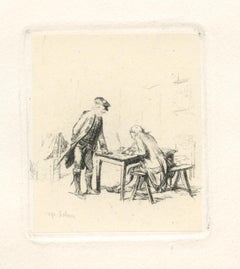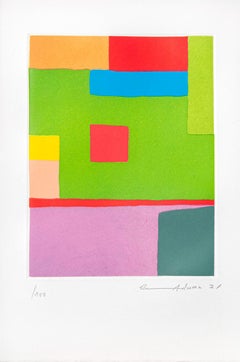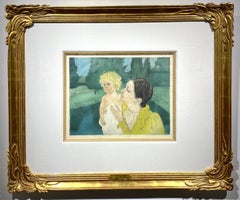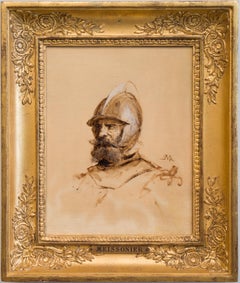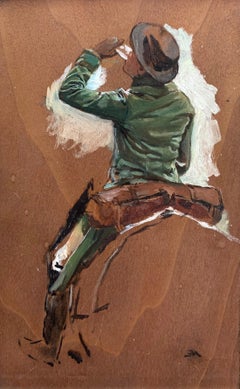Jean-Louis Ernest Meissonier Art
to
1
Overall Width
to
Overall Height
to
1
1
1
1
1
10,082
2,769
1,381
1,375
1
Artist: Jean-Louis Ernest Meissonier
"Le Sergent Rapporteur" original etching
By Jean-Louis-Ernest Meissonier
Located in Henderson, NV
Medium: original etching. Catalogue reference: Beraldi 14. This impression on chine colle paper was published by the Gazette des Beaux-Arts in 1903. Plate size: 2 1/2 x 2 1/8 inches ...
Category
Early 1900s Jean-Louis Ernest Meissonier Art
Materials
Etching
Related Items
Fil du Temps
By Etel Adnan
Located in London, GB
Etel Adnan "Fil du Temps" 2021. Etching on wove paper. Edition of 100.
A critical work by Adnan, the final etching in this series. Etel was unable to put pencil to paper due to her ...
Category
2010s Abstract Impressionist Jean-Louis Ernest Meissonier Art
Materials
Etching
Mary Cassatt "By the Pond"
By Mary Cassatt
Located in Los Angeles, CA
Mary Cassatt 1844 - 1926
"By the Pond" (Breeskin 161; Matthews & Shapiro 21)
Drypoint and aquatint printed in colors, circa 1896, on laid paper, framed
Fourth state of four.
Plate:...
Category
1890s Jean-Louis Ernest Meissonier Art
Materials
Drypoint, Aquatint
Carriage engraving from the Encyclopedie ( Sellier Carossier )
By Denis Diderot
Located in New York, NY
Carriage engraving from the Encyclopedie ou Dictionnaire raisonne des sciences, des arts et des metiers, par une societe de gens de lettres. edited by Denis Diderot and Jean le Rond ...
Category
Late 18th Century French School Jean-Louis Ernest Meissonier Art
Materials
Engraving, Etching, Intaglio
$160 Sale Price
20% Off
H 16 in W 20 in
Untitled (Anxious Head)
By Rashid Johnson
Located in London, GB
Rashid Johnson "Untitled" Anxious Print. Soft-ground etching on Hahnemühle paper. Published by Phaidon. Boxed, including folio, print and book as issued. Edition of 100. Hand signed ...
Category
2010s Contemporary Jean-Louis Ernest Meissonier Art
Materials
Etching
Carriage engraving from the Encyclopedie ( Sellier Carossier )
By Denis Diderot
Located in New York, NY
Carriage engraving from the Encyclopedie ou Dictionnaire raisonne des sciences, des arts et des metiers, par une societe de gens de lettres. edited ...
Category
Late 18th Century French School Jean-Louis Ernest Meissonier Art
Materials
Engraving, Etching, Intaglio
$160 Sale Price
20% Off
H 16 in W 20 in
Carriage engraving from the Encyclopedie ( Sellier Carossier )
By Denis Diderot
Located in New York, NY
Carriage engraving from the Encyclopedie ou Dictionnaire raisonne des sciences, des arts et des metiers, par une societe de gens de lettres. edited by Denis Diderot and Jean le Rond ...
Category
Late 18th Century French School Jean-Louis Ernest Meissonier Art
Materials
Engraving, Etching, Intaglio
$160 Sale Price
20% Off
H 16 in W 20 in
Plate 1, from: Half-Life (after Rembrandt)
By Glenn Brown
Located in London, GB
This is a truly stunning work by contemporary great, Glenn Brown. This work is an Artist Proof, one of only 12 created.
The frame is handmade by famous London framers, Darbyshire. I...
Category
2010s Abstract Expressionist Jean-Louis Ernest Meissonier Art
Materials
Paper, Etching
Carriage engraving from the Encyclopedie ( Sellier Carossier )
By Denis Diderot
Located in New York, NY
Carriage engraving from the Encyclopedie ou Dictionnaire raisonne des sciences, des arts et des metiers, par une societe de gens de lettres. edited ...
Category
Late 18th Century French School Jean-Louis Ernest Meissonier Art
Materials
Engraving, Etching, Intaglio
$160 Sale Price
20% Off
H 16 in W 20 in
Carriage engraving from the Encyclopedie ( Sellier Carossier )
By Denis Diderot
Located in New York, NY
Carriage engraving from the Encyclopedie ou Dictionnaire raisonne des sciences, des arts et des metiers, par une societe de gens de lettres. edited ...
Category
Late 18th Century French School Jean-Louis Ernest Meissonier Art
Materials
Engraving, Etching, Intaglio
$160 Sale Price
20% Off
H 16 in W 20 in
Carriage engraving from the Encyclopedie ( Sellier Carossier )
By Denis Diderot
Located in New York, NY
Carriage engraving from the Encyclopedie ou Dictionnaire raisonne des sciences, des arts et des metiers, par une societe de gens de lettres. edited ...
Category
Late 18th Century French School Jean-Louis Ernest Meissonier Art
Materials
Engraving, Etching, Intaglio
$160 Sale Price
20% Off
H 16 in W 20 in
Carriage engraving from the Encyclopedie ( Sellier Carossier )
By Denis Diderot
Located in New York, NY
Carriage engraving from the Encyclopedie ou Dictionnaire raisonne des sciences, des arts et des metiers, par une societe de gens de lettres. edited ...
Category
Late 18th Century French School Jean-Louis Ernest Meissonier Art
Materials
Engraving, Etching, Intaglio
$160 Sale Price
20% Off
H 16 in W 20 in
Carriage engraving from the Encyclopedie ( Sellier Carossier )
By Denis Diderot
Located in New York, NY
Carriage engraving from the Encyclopedie ou Dictionnaire raisonne des sciences, des arts et des metiers, par une societe de gens de lettres. edited by Denis Diderot and Jean le Rond ...
Category
Late 18th Century French School Jean-Louis Ernest Meissonier Art
Materials
Engraving, Etching, Intaglio
$160 Sale Price
20% Off
H 16 in W 20 in
Previously Available Items
Head of a Soldier by Ernest Meissonier, Oil on Canvas, Signed With Monogram
By Jean-Louis-Ernest Meissonier
Located in Stockholm, SE
Ernest Meissonier (1815–1891) was one of the most internationally successful
and celebrated artists of his time – but became almost completely forgotten in the 20th century.
Not un...
Category
19th Century Jean-Louis Ernest Meissonier Art
Materials
Canvas, Oil
Un Voyageur (A Traveler) by Jean Louis Ernest Meissonier, Oil on Panel
By Jean-Louis-Ernest Meissonier
Located in Stockholm, SE
JEAN LOUIS ERNEST MEISSONIER (1815-1891)
UN VOYAGEUR (A TRAVELER)
Ernest Meissonier – Glimpse of a forgotten master
Some artists become famous after their death. For others, the fate is reversed. Ernest Meissonier (1815–1891) was one of the most internationally successful and celebrated artists of his time – but became almost completely forgotten in the 20th century. Not until now is the name of Meissonier starting to be re-introduced to its rightful place in art history, and this sketch is a rare example of why.
“–All of us will be forgotten, but Meissonier will be remembered" the painter Eugène Delacroix once said in a conversation with poet Charles Baudelaire. Back then, it was unthinkable to see Meissonier as anything else than one of the most famous and beloved artists alive. His paintings fetched the highest prices and audiences flocked to see his works on exhibitions. Through reproductions and prints the fame of Meissonier spread even wider, and when new major works were exhibited newspapers around Europe were quick to report. Napoleon III employed him as a member of the imperial court to paint military victories and Kaiser Wilhelm II of Germany, who also collected his works, said that Meissonier was “One of the greatest glories of the entire world”. John Ruskin, one of the most influential art critics of his day, was "marvelling at Meissonier's manual dexterity and eye for fascinating minutiae". So, what was it that captivated the 19th century audience in the art of Meissonier?
Formally, Meissonier belonged to the academic tradition and is mainly known for his history paintings, motifs of Napoleonic battles and victories, genre pieces and some portraits. He was both a painter and a sculptor, and also an accomplished engraver. But beyond the motifs and techniques there were other, more intangible qualities to his art. Like no one else Meissonier could produce almost cinematic artworks filled with bombastic happenings, calm poetry or psychologically precise portraits; all balancing between an extraordinary sense of detail and striking compositions. He is often compared as an artistic parallel to writer Alexandre Dumas in his unique ability to convey stories of pre-Revolutionary France, with all its honourable chivalry and heroic tales.
Many of his motifs, especially the military scenes, were of great emotional value to the 19th century audience and filled with symbols and references that have long lost their meaning. Meissonier knew how to set the scene and boil down to the perfect moment in a story where it reached its full dramatic potential. Weather he painted battle scenes or portraits, Meissoniers artworks had a curious ability to make the viewer submerged into the scene. Technically, what first seems like an extremely realistic and slightly formal way of painting is on a closer inspection shaped by fast, playful and almost carelessly performed strokes of paint that make the motifs vibrate of life. His tendency to only paint rather small formats also provided a kind of intimacy even to his more pompous sceneries.
This sketch here is an interesting fragment of how this master worked. It was sold just two years after his death in 1893 at the great Meissonier studio sale at Galerie Georges Petit in Paris as lot number 171 and is painted directly on a wooden panel. On the back there are two old labels and the wax seal from the “Vente Meissonier 1893” that can be found on several other works sold at the same occasion. In what is probably a contemporary handwriting it is described as “Etude d'un voyageur devant un Cabaret [...] sa direction”, translated to “Study of a traveller in front of a cabaret, his direction”. (The term “cabaret” possibly refers to the tube-shaped bag on the back of the saddle.)
What we see is the back of a man seated on a horse, who is barely visible through just a few strokes in black. He is dressed in a green riding outfit wearing boots, gloves and a hat. In his left hand he is holding a glass from which he drinks, bottoms up. Around him, in an almost halo-like manner, strokes of white and pale yellow are added to suggest light and compare the depth of the colours. The grain of the wooden panel also creates a beautiful backdrop, perfectly matching the rustic nature of the subject.
In these few strokes of paint we see how Meissonier built up colour, texture, movement and light in order to create that special energy that is so characteristic for his art. Effortlessly going from thick layers of paint to thin and barely visible lines show the confident fluency that only a true master can possess.
It is currently unknown what specific painting this sketch belong to, but as interest in Meissonier grows more research and comparisons can provide new knowledge in the future. Till then, this sketch remains a fascinating fragment of the working process behind one of the most successful yet forgotten artists of Western art history.
signed with monogram EM
with the Vente Meissonier 1893 wax seal (on the reverse)
oil on panel
c.1882
panel size:6,7x4,3 inches (17x11 cm)
frame: 11.02 x 8.26 inches (28 x 21 cm)
PROVENANCE:
The Artist's studio sale, Galerie Georges Petit, Paris,
12-17 May 1893, lot 171;
Faerber & Maison Ltd, London 1972;
Private collection Sweden
Literature:
Ernest Meissonier: rétrospective (catalogue), Musée des Beaux-Arts de Lyon, 25 mars-27 juin 1993, Réunion des Musées Nationaux, Pairs 1993
The plight of emulation: Ernest Meissonier and French salon painting...
Category
Late 19th Century Jean-Louis Ernest Meissonier Art
Materials
Oil, Board
Jean-louis Ernest Meissonier art for sale on 1stDibs.
Find a wide variety of authentic Jean-Louis Ernest Meissonier art available for sale on 1stDibs. You can also browse by medium to find art by Jean-Louis Ernest Meissonier in canvas, etching, fabric and more. Not every interior allows for large Jean-Louis Ernest Meissonier art, so small editions measuring 3 inches across are available. Customers who are interested in this artist might also find the work of Henri Fantin-Latour, Jean-Francois Raffaelli, and Paul Iribe. Jean-Louis Ernest Meissonier art prices can differ depending upon medium, time period and other attributes. On 1stDibs, the price for these items starts at $100 and tops out at $8,789, while the average work can sell for $4,444.
